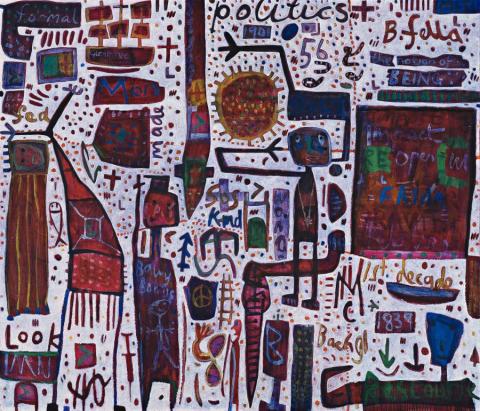WHAT A MONTH, 1995
DAVID LARWILL
oil on canvas
182.0 x 213.0 cm
signed with initials and dated upper left: D.L / 95
signed, dated and inscribed verso: What a month / David Larwill / 1995
Sam Larwill, the artist's brother
Lawson~Menzies, Sydney, 22 July 2003, lot 46
Private collection
Christie's, Melbourne, 22 August 2005, lot 3
Private collection, Melbourne
As the title suggests, What a Month presents a myriad of experiences and ideas from an intense period of the artist's life here assembled onto the canvas. Larwill's paintings are often self-reflective and his imagery in this work incorporates a wide range of personal references, combined with an awareness of political and social issues pertinent at the time of its creation, such as racial tensions, sovereignty, and the introduction of the baby bonus. A key feature of Larwill's paintings is the absence of a single focal point. Here, the eye is led methodically around the complex composition populated by lively figures and symbols - people, ships, animals, words, and the blazing sun - none of which take precedence over the others.
What a Month is painted in Larwill's trademark naive, child-like style. His aesthetic calls to mind a host of references, including urban and graffiti art, the CoBrA movement that emerged in Europe in the 1940s, and the French pioneer of art brut who had a tremendous impact on the artist, Jean Dubuffet (1901-85). Larwill employs a deliberately primitive and instinctive style that is all cheek, urgency and delight. This is not to say, however, that there is any simplicity to his painting process. Larwill paints with thick layers of dynamic colour, utilising an impasto technique. He begins with a coloured background and then blocks in his forms using white, to create images that seem almost translucent - allowing us to see the ghosts of what lies beneath and the complexity of his ideas beyond their surface appearance.
'Larwill's pictures are painted over and over, literally layered in transparent overpainting in different colours as he searches for a good image. What goes in first does not matter since his pictures are not a battle for subject matter. Rather, they express something personal and immediate about his emotional state, including, on occasions, the sense of disconnection between his thoughts, feelings and actions.'1
Larwill has found tremendous success locally and abroad. He was one of the founding members of ROAR Studios and in 1986 he was commissioned by the Victorian government to paint one of Melbourne's W-class trams. Numerous other commissions soon followed from esteemed bodies including the Australian Opera and the Australian Football League. His works have been collected by many leading art bodies including the British Museum, London; the National Gallery of Australia, Canberra; the National Gallery of Victoria, Melbourne; and the Queensland Art Gallery, Brisbane. Private buyers include the Holmes à Court Collection and the Baillieu Myer Collection.
1. Felicity St John Moore, cited in McGregor, K., David Larwill, Craftsman House, Sydney, 1997, pp. 8-9
LEAH CROSSMAN
The Estate of David Larwill. Courtesy of Fiona Larwill and Sotheby's Australia
